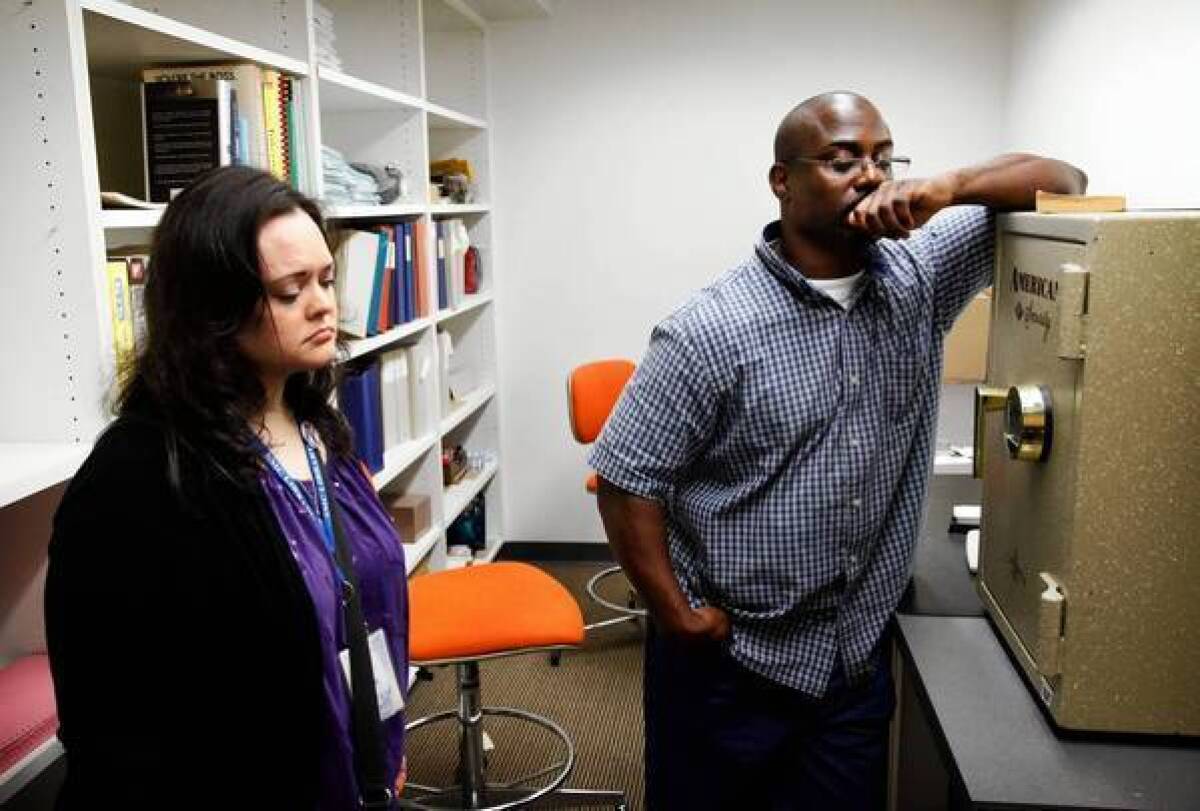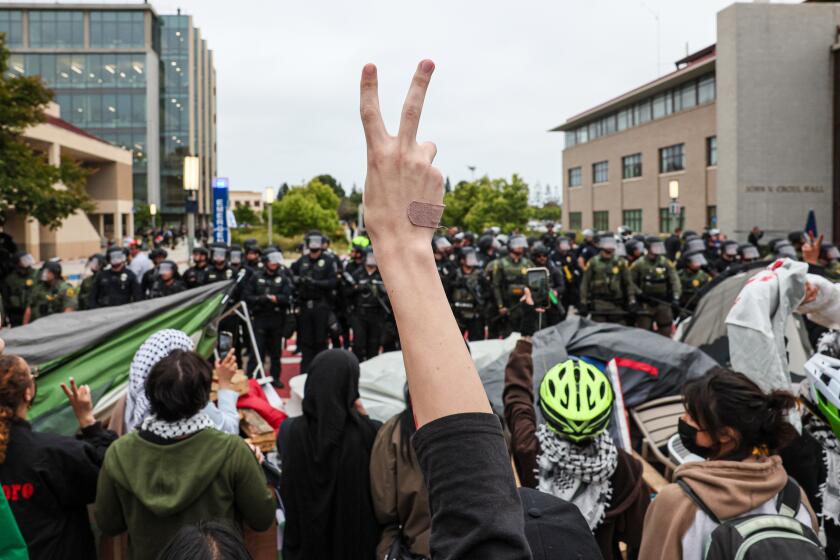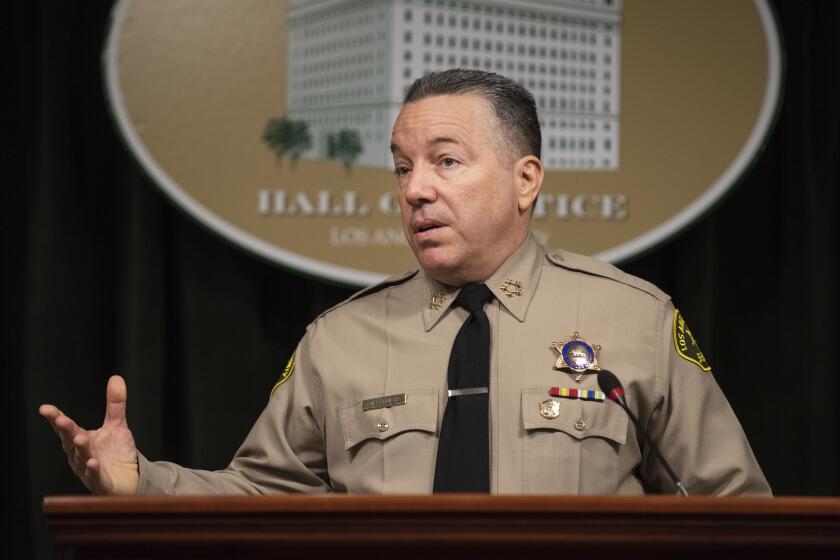Santa Monica College library workers’ ‘diversion’ saved lives

Jan Juliani was standing behind the counter of the Santa Monica College library about noon when a group of terrified, screaming students sprinted through the entrance. One was running backward, shouting: “He has a gun!”
Juliani knew exactly what to do. Recalling a lesson from a recent workshop on how to respond during “active shooter” incidents, the library assistant, 34, headed for a set of double doors that led to a storage closet in the back office.
Other library workers followed her. Shutting the closet door seemed to take forever because of resistance from the pneumatic closer. By then, a gunman had stepped into the library and was headed their way. Moments later, he fired into the rectangular room. Bullets sailed through furniture and walls, narrowly missing those inside.
Police now say the library workers’ actions inadvertently created a distraction that allowed dozens of others to escape the library while the gunman focused on those huddled in the closet.
“The diversion they provided really saved everybody else in this complex,” Santa Monica College Police Chief Albert Vasquez said.
Police soon fatally shot John Zawahri, 23, inside the library, bringing to an end a rampage during which he killed five people.
This week, Juliani and co-worker Myron Kabwe took a Los Angeles Times reporter into that narrow closet and described what happened June 7. They don’t call themselves heroes, although others on campus have. Still, Juliani’s new nickname for Kabwe is “Captain Awesome.”
Kabwe, 47, a computer support specialist who usually works upstairs, was working behind the counter with Juliani when the commotion began. An off-duty student library worker had been thanking him for recommending the Richard Wright book “Black Boy,” which she held in her hand.
Hearing the shouts, Kabwe looked up into the eyes of a man, dressed in black and carrying a rifle at his side, who was walking calmly into the foyer. “Why is a police officer scaring children?” Kabwe wondered before realizing a split-second later: “This is not a police officer.” Kabwe slid behind a wall.
Although Kabwe’s instinct was to direct colleagues to an exit perhaps 50 yards away at the end of an exposed hall, he saw Juliani inside the closet and followed her. They helped herd seven other workers inside. Once two women finally closed the balky door, the group pushed a safe in front of it. Kabwe urged everyone to get low, and they sprawled on the floor or huddled under the table.
Crouching on the floor, Juliani texted her father: “I am OK.” Known for his dry wit, James Juliani replied: “I certainly hope so but is there an explanation that goes with your somewhat cryptic text? Love, Papa.” His daughter responded, matter of fact: “Shooting in the library. We are hiding out in the cash room waiting for police.” His response: “Hope you blocked the door.”
The library workers heard the man say he was a police officer. He banged on the door and, in a conversational tone, said he would count to five. He did and then began firing. Inside the room, Kabwe, the last to get down, saw holes appear in the walls and door and counted nine rounds. Bullets splintered a table leg and nicked a safe but miraculously missed the seven women and two men.
Meanwhile, dozens of students who had been cramming for finals were escaping the library through a rear exit.
What the workers inside the storage closet did not know was that three police officers — two from the Santa Monica Police Department and one from the campus force — had rushed into the library and exchanged fire with the gunman, their bullets pocking concrete walls and wooden doors and striking Zawahri. The officers disarmed and handcuffed him and dragged him outside to a sidewalk, where he died.
The library workers stayed put in their hideaway for a while, laughing nervously and checking Twitter and other feeds. Finally, they believed the all-clear messages they were receiving. They emerged and met up with colleagues, including their relieved boss, Mona Martin, dean of learning resources. She had been lunching off-campus when the drama began and stayed in touch by text-message from behind the police tape.
The college held its graduation Tuesday, commemorating those who died in the shootings and looking toward the future. By Thursday, when the library co-workers gave their account, the campus was all but deserted. Memorial candles and posters were placed across the campus at locations where the gunman had claimed victims.
Little evidence of the mayhem remained in the library. Bullet holes had been patched. Glass doors and windows that were blown out or splintered had been replaced. Some of the industrial carpeting along the path where police officers had dragged the gunman’s bleeding, nearly lifeless body had been sliced away.
Police on Friday were still attempting to determine Zawahri’s motive. Authorities say he killed his father and brother in the family home in Santa Monica’s Pico neighborhood and set it on fire. He then carjacked a passing motorist and ordered her to drive him to Santa Monica College, less than a mile away. As neighbors watched in horror, he fired on a passing sedan, wounding the female driver.
On the quick ride to campus, he fired through several windows of a Santa Monica Big Blue Bus. Once at the campus, he shot into a red SUV, killing the male driver and mortally wounding his daughter. The vehicle crashed through a brick wall at a parking lot on Pearl Street, at the southern end of campus.
Witnesses said Zawahri strolled calmly and casually through the hallway of the liberal arts building. Emerging into the open near a fig tree, he killed a 68-year-old woman who had been collecting recyclables. He then climbed the steps to the library and entered through the sliding glass doors.
Back inside the cash room this week, Kabwe found the paperback copy of Wright’s “Black Boy” that the student worker had left behind after hunkering down with him, Juliani and the others. “We need to give this to her,” he told Juliani. “She hasn’t finished it.”
More to Read
Sign up for Essential California
The most important California stories and recommendations in your inbox every morning.
You may occasionally receive promotional content from the Los Angeles Times.











